
NASA
Axiom Space’s Next-Gen Spacesuit is Crew Tested for First Time in NASA’s Neutral Buoyancy Lab (News Release)
In June, Koichi Wakata, Axiom Space astronaut and Chief Technology Officer, was the first to test the Axiom Extravehicular Mobility Unit (AxEMU) in NASA’s Neutral Buoyancy Laboratory (NBL).
The Axiom Space-developed spacesuit will enable astronauts to explore the Moon for the first time in over 50 years as part of the Artemis III mission to the lunar South Pole.
The tests were first conducted with Wakata, followed by NASA spacesuit engineers Kristine Davis and Richard Rhodes, and focused on the integration of the AxEMU into the NBL facility. The NBL is one of the world's largest indoor pools, used for astronaut training and mission preparation, allowing astronauts to simulate lunar surface tasks in partial gravity or spacewalks in zero gravity.
The Axiom Space Extravehicular Activity (EVA) program team tested the operations and capabilities of the communications, breathing and cooling systems of the spacesuit in the pool. The team worked to familiarize the NBL divers with the AxEMU’s operations and support systems.
In preparation of the Artemis III mission, Axiom Space and NASA’s Artemis Program teams will continue to conduct tests in the NBL to train for EVA tasks on the lunar surface.
The AxEMU continues to undergo extensive testing to ensure that it will be ready to support Artemis III. This year, the EVA program team accomplished several key achievements, including completing its first three crewed tests in the NBL; 23 tests in NASA’s Active Response Gravity Offload System (ARGOS) that provides a simulated reduced gravity environment; multiple field evaluations using lunar tools; and lunar regolith challenge testing demonstrating that the suit exceeds its mission requirements in this area. The spacesuit continues to undergo integrated tests with the Lunar Terrain Vehicles (LTVs) and is scheduled to enter the Critical Design Review (CDR) later this year.
Axiom Space remains laser-focused on the development of this next-generation spacesuit providing astronauts with increased flexibility, mobility and safety capabilities. Stay tuned to axiomspace.com/axiom-suit for more updates.
Source: Axiom Space
****

















